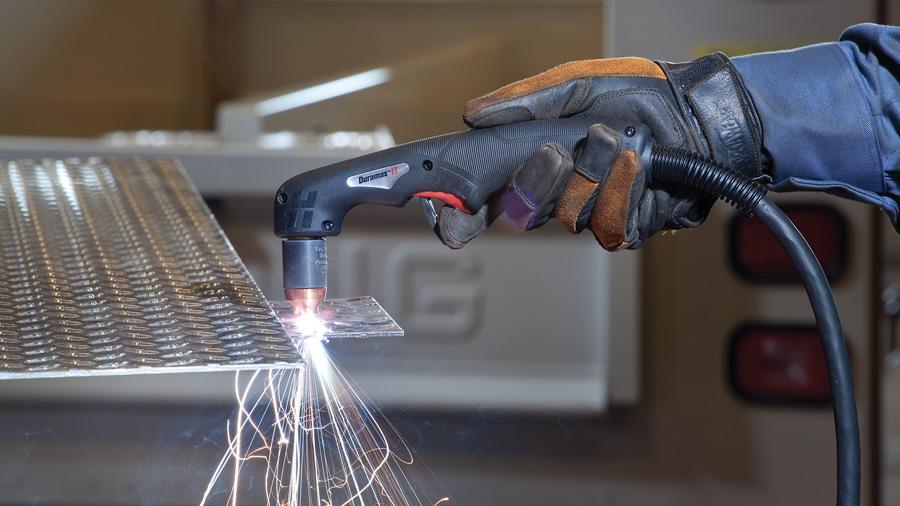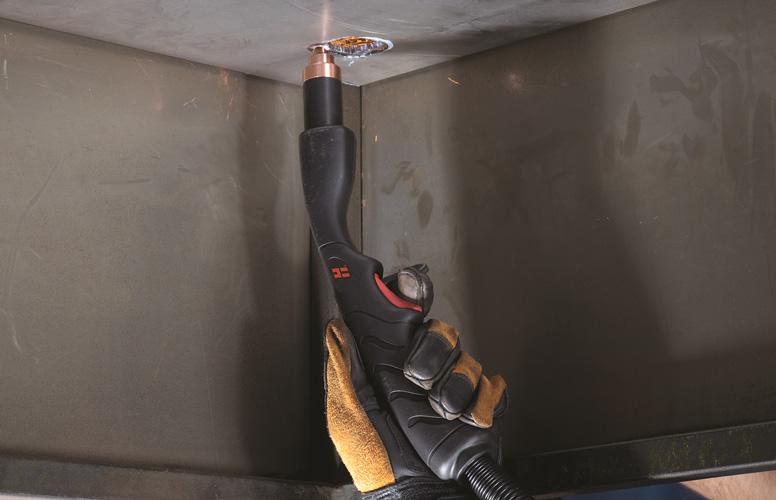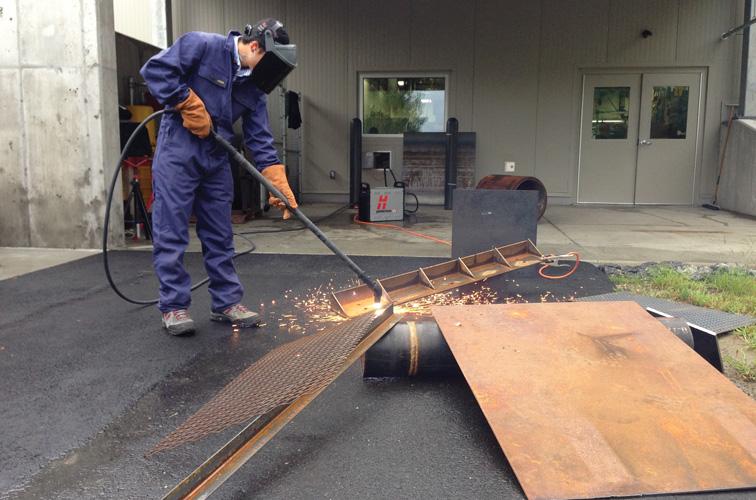Communications Manager
- FMA
- The Fabricator
- FABTECH
- Canadian Metalworking
Categories
- Additive Manufacturing
- Aluminum Welding
- Arc Welding
- Assembly and Joining
- Automation and Robotics
- Bending and Forming
- Consumables
- Cutting and Weld Prep
- Electric Vehicles
- En Español
- Finishing
- Hydroforming
- Laser Cutting
- Laser Welding
- Machining
- Manufacturing Software
- Materials Handling
- Metals/Materials
- Oxyfuel Cutting
- Plasma Cutting
- Power Tools
- Punching and Other Holemaking
- Roll Forming
- Safety
- Sawing
- Shearing
- Shop Management
- Testing and Measuring
- Tube and Pipe Fabrication
- Tube and Pipe Production
- Waterjet Cutting
Industry Directory
Webcasts
Podcasts
FAB 40
Advertise
Subscribe
Account Login
Search
Plasma cutting torches: the long and short of it
Torches and consumables take on a whole new look, increasing range of plasma cutting applications
- By Michelle Avila
- April 2, 2015
- Article
- Plasma Cutting
Every new technology, from automobiles to televisions, goes through an evolutionary period. The first designs often are large and expensive and slowly become smaller, faster, more refined, and user-focused. Think back to the first computer or cell phone. Both looked nothing like the advanced tablets and smartphones of today.
Today's plasma cutting systems are no different. Power supplies are smaller, more capable, and reliable, as are the cutting torches. The first torches were squared-off, clunky hunks of plastic that looked more like a child's toy hammer than high-tech cutting equipment. These torches did the trick, but as plasma cutting and gouging evolved, it became clear torches needed to evolve as well to withstand harsher conditions and meet a wider variety of needs. After all, the torch that cuts perfect parts on a CNC table isn't necessarily the torch that works well in a 3-D cutting application. For hand cutting, a torch used to cut a flat piece of steel doesn't necessarily work for someone trying to gouge out a weld on the pipeline.
Although engineers saw and understood the need for different torch designs, the process of actually making these torches a reality was more complicated. There was a reason plasma torches were designed the way they were, and it had to do with the mechanism that starts the plasma arc. Normally, that mechanism is built in to most plasma torches in the form of a plunger. When the trigger is pressed, an internal mechanism pushes the plunger into the electrode, which in turn hits the nozzle and starts the arc. Any design change had to take this starting method into account.
Engineers quickly realized the solution was to remove the starting mechanism from the torch and build it into the electrode. It wasn't easy, but after much work, engineers figured out a way to get rid of the plunger inside the torch body and replace it with a blowback spring on the back end of the electrode. This technology opened up all sorts of possibilities for torch design as engineers were no longer limited to a certain size or shape.
As a result, many different torch styles are available today: short, long, angled, straight. They are made for both hand-held and mechanized cutting and gouging, as well as robotic cutting. Let's take a look at some of these torches and the jobs they might be good for.
Hand-held Cutting
75-degree or 90-degree Torch—This traditional jack-of-all trades cutting torch is shaped roughly like the letter L (Figure 1). Though the torch, and especially the consumables inside, has evolved through the years, this is essentially the torch introduced with the advent of commercial plasma four decades ago. It can easily handle most common cutting jobs, although another torch might serve you better for specific jobs and applications.
15-degree Torch—As the name implies, this torch is designed with a very slight 15-degree angle, making it nearly straight. You might want to use a torch like this is for gouging.
The straighter design provides more visibility and better arc control while keeping your hand away from the high heat generated by the gouging process. This also is a good torch for cutting in corners, as shown in Figure 2.
45-degree and 90-degree Long Torches—Unlike the torches previously mentioned, which are from roughly 10 to 12 inches in length, these torches (Figure 3) are 2 and 4 feet long. Available with two different angles each (45 degrees and 90 degrees), these torches are made for hand-held cutting.
They are appropriate for jobs in which you don't want to get close to the workpiece (dismantling a boiler with lead paint, for example) or for jobs like scrapping and skeleton cut-up. The extra length makes it possible to do these jobs without bending over. Long torches also are handy for cutting items high above you, like in a ceiling, without having to climb a ladder.
Mechanized Cutting
180-degree Full-length Machine Torch—This torch (Figure 4) is a traditional torch suitable for use on portable automation tools like track cutters and most any type of CNC table.
180-degree Mini Machine Torch—The mini machine torch (Figure 5) is helpful for situations in which the full-length torch is too long. Its shorter length (approximately 7 in. compared with about 16 in. for a full-length torch) makes it ideal for smaller CNC tables and pipe cutters.
Robotic Cutting
Unlike torches designed for mechanized cutting, robotic torches (Figure 6) tend to weigh less, have a smaller profile (both shorter and thinner), and have features such as ridges and grooves, holes, and clamps. These features make it easier and faster to position the torch on the robotic arm and ensure that it doesn't inadvertently slip out of place during cutting.
Like robots themselves, the torches come in a range of shapes, from completely straight to L-shaped and everything in between.
Consumable Advancements
Engineers also have made advances in plasma consumables. The blowback spring on the back end of the electrode was just a start. A notable example is tapered consumables that extend 3 in. longer than standard consumables. This design is useful for cutting or gouging metal in a location where space is so limited that there isn't room for a traditional torch, let alone your hand. Examples are up inside a wheel well and a tight compartment on a ship. The long, thin design of these consumables makes it easier to get the torch into the area needing to be cut.
Another advantage of this design is visibility. It is easier for you to see the workpiece. Longer-length consumables also are advantageous when cutting parts with deep channels or crevices.
No matter the job, new plasma torch and consumable designs are allowing you to tackle more jobs with less frustration. For the first time, plasma users now have the same level of innovation and flexibility that oxyfuel users have long had when it comes to shapes and length.
All photos courtesy of Hypertherm.
About the Author
Michelle Avila
603-643-3441 ext. 1145
Related Companies
subscribe now

The Fabricator is North America's leading magazine for the metal forming and fabricating industry. The magazine delivers the news, technical articles, and case histories that enable fabricators to do their jobs more efficiently. The Fabricator has served the industry since 1970.
start your free subscription- Stay connected from anywhere

Easily access valuable industry resources now with full access to the digital edition of The Fabricator.

Easily access valuable industry resources now with full access to the digital edition of The Welder.

Easily access valuable industry resources now with full access to the digital edition of The Tube and Pipe Journal.
- Podcasting
- Podcast:
- The Fabricator Podcast
- Published:
- 04/16/2024
- Running Time:
- 63:29
In this episode of The Fabricator Podcast, Caleb Chamberlain, co-founder and CEO of OSH Cut, discusses his company’s...
- Trending Articles
How to set a press brake backgauge manually

Capturing, recording equipment inspection data for FMEA

Tips for creating sheet metal tubes with perforations

Are two heads better than one in fiber laser cutting?

Hypertherm Associates implements Rapyuta Robotics AMRs in warehouse

- Industry Events
16th Annual Safety Conference
- April 30 - May 1, 2024
- Elgin,
Pipe and Tube Conference
- May 21 - 22, 2024
- Omaha, NE
World-Class Roll Forming Workshop
- June 5 - 6, 2024
- Louisville, KY
Advanced Laser Application Workshop
- June 25 - 27, 2024
- Novi, MI





























